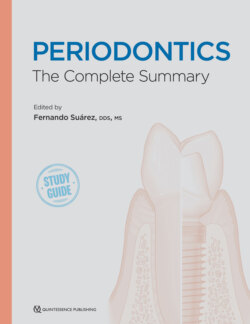Читать книгу Periodontics - Fernando Suarez - Страница 93
На сайте Литреса книга снята с продажи.
CLASSIFICATION OF FURCATION DEFECTS
ОглавлениеClassification systems for furcations were developed to help determine the extension of the defect, tooth prognosis, and treatment approaches. These classifications were mostly developed with the use of a Nabers probe. Both horizontal and vertical components represent the primary endpoints of these classification systems.1,76–94 Table 5-5 summarizes some of the most commonly employed classifications.1,76,83,84,87,90
TABLE 5-5 Classification systems for furcation defects
| Authors | Criteria |
| Glickman76 | Pattern of destruction: Horizontal and vertical component.Grade I: Furcation area without gross or radiographic evidence of loss of alveolar bone loss (incipient defect).Grade II: Bone loss in one or more aspects of the furcation area, but a portion of the alveolar bone and periodontal membrane remains intact (also known as cul-de-sac lesion).Grade III: Alveolar bone destruction permits the complete passage of a probe through the furcation. Entrance might be occluded by gingival tissues (through-and-through defect).Grade IV: Alveolar bone destruction creates an open area through which a probe can be passed without difficulty. The entrance is exposed and clearly visible to clinical examination. |
| Hamp et al,83 Lindhe and Nyman87 | Pattern of destruction: Horizontal component.Degree I: Horizontal loss of periodontal support less than 3 mm.Degree II: Horizontal loss of periodontal support exceeding 3 mm, but not encompassing the total width of the furcation.Degree III: Horizontal “through-and-through” destruction of the periodontal tissue in the furcation. |
| Nyman and Lindhe84 | Pattern of destruction: Horizontal component.Class I: Horizontal loss of periodontal support not exceeding one-third of the width of the tooth.Class II: Horizontal loss of periodontal support exceeding one-third of the width of the tooth, but not encompassing the total width of the furcation.Class III: Horizontal “through-and-through” destruction of the periodontal tissue in the furcation. |
| Tarnow and Fletcher90 | Pattern of destruction: Vertical component.Subclass of Lindhe and Nyman87 classification.Subclass A: 0–3 mm probable depth from the roof of the furcation.Subclass B: 4–6 mm probable depth from the roof of the furcation.Subclass C: 7 mm or greater probable depth from the roof of the furcation. |
| American Academy of Periodontology Glossary of Periodontal Terms1 | Pattern of destruction: Horizontal component.Class I: Incipient loss of bone limited to the furcation flute that does not extend horizontally.Class II: A variable degree of bone loss in a furcation, but not extending completely through the furcation.Class III: Bone loss extending completely through the furcation. |
